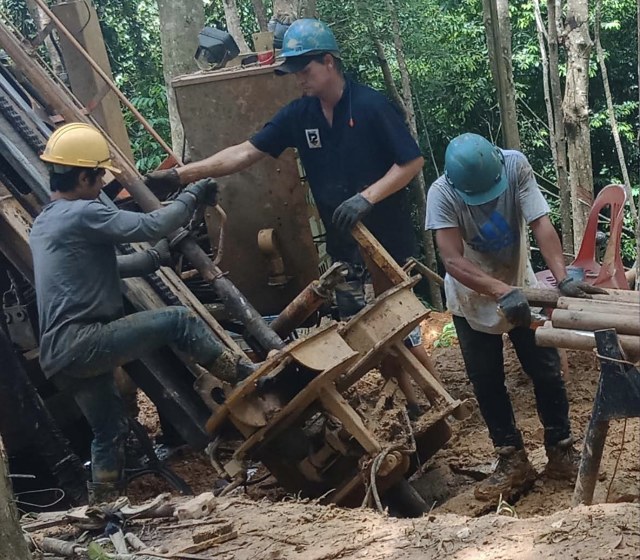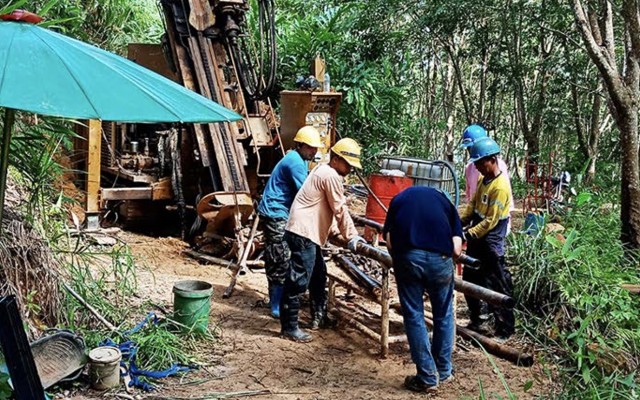Pan Asia Metals IPO to give investors exposure to low-cost South East Asian lithium and tungsten assets

Pan Asia’s strategy is to develop low cost lithium and tungsten projects, including downstream processing, on South East Asia’s electric vehicle doorstep.
Specialty metals explorer Pan Asia Metals is hoping to take advantage of the next forecast lithium wave driven by increasing uptake of new technologies, electric vehicles and renewable energies, while also firming up its tungsten assets.
Unlike many lithium hopefuls, which are targeting Australia, South America and Africa for the commodity, Pan Asia is focused on advancing low cost lepidolite-rich deposits in South East Asia.
The company is also exploring for tungsten in the region and owns the Minter tungsten project in central New South Wales, Australia.
To advance its plans of unlocking the value of its assets, Pan Asia hopes to raise between $4 million and $6 million (before costs) via the issue of up to 30 million shares at $0.20 each in an initial public offering.
Once listed on the ASX, Pan Asia plans to trade under the ticker code ‘PAM’ with an indicative market capitalisation of $26.9 million.
The IPO was launched in early July, with the company targeting a late September listing.
‘Low-cost assets in a low-cost jurisdiction’
According to Pan Asia, what sets it apart from other resource juniors is its focus on “low cost assets” in South East Asia, which is also a highly cost competitive region to operate within.
Despite being low cost, the region hosts sophisticated industrial economies, including Thailand and Malaysia.
In the 2018 economic complexity index, Malaysia came in at 25, Thailand at 28, with China ranking 29 and Australia further down the list at 72.
Adding to the picture is Thailand hosting South East Asia’s number one auto industry, with a focus on producing electric vehicles as a result of its government policy.
“Operating in South East Asia, especially in Thailand and Malaysia, gives the company access to modern industrial economies with globally competitive cost environments,” Pan Asia executive chairman and managing director Paul Lock explained.
He added the projects were also close to larger markets in Asia, which is the “fastest growing and most populous region on earth”.
“Our strategy is simple, we seek to exploration and development assets, which have the potential to be positioned in the lowest or leading third of the cost curve, and which position the company for downstream value adding opportunities,” he said.
“Cost curve positioning is paramount in our decision making.”
Mr Lock pointed out assets further up in the cost curve are more difficult to finance and develop.
Additionally, it is important to Pan Asia to have the ability to move downstream.
“In general, value adding mine output will offer the company better and more consistent profit margins and a larger footprint of customers, and exposure to new opportunities,” Mr Lock said.
Pan Asia’s high priority assets include the Khao Soon tungsten project and Reung Kiet lithium project, which are both found in Thailand’s south and fit with the company’s downstream strategy and required proximity to end-user markets.
Khao Soon tungsten project
Khao Soon is located within the Nakhon Si Thammarat Province, which is about 600km south of Bangkok.
The project includes an exploration licence and two applications which cover about 35sq km and include the Khao Soon tungsten deposit.
Siam American Mining Enterprises discovered Khao Soon in 1970, but before the government granted a mining concession, about 30,000 people flocked to the area and begun mining the area illegally until the Thai Army was called in to control the situation in 1976.
Khao Soon was operated as an underground mine for about 10 years until about 1980, but little information is available due to the illegal and unco-ordinated mining carried out.
However, the US Bureau of Mines Mineral Yearbooks offer “several cursory references” to Khao Soon, according to Pan Asia.
The company claims these references include the deposit being responsible for “half or much of all tungsten production” in Thailand and 75% of the region’s wolframite output.
Recorded tungsten concentrate production for the country between 1971 and 1980 was about 44,000 tonnes.
Pan Asia believes actual production would have been greater and estimates output from Khao Soon was between 10,000t and 20,000t for the period.
Importantly, cessation of mining at the deposit has been attributed to price decreases not depletion of ore.
Pan Asia has been exploring Khao Soon itself since 2014 and has recovered numerous tungsten in soil anomalies exceeding 0.1% over 4km of strike.

Diamond core drilling taking place at the Khao Soon tungsten project.
Additionally, drilling has uncovered mineralisation from surface in many holes, with geophysics surveys indicating several deeper targets.
To-date, Pan Asia has completed 22 diamond drill holes at the project for a total of 1,912m.
A highlight result is 51.5m at 0.50% tungsten from surface, including 12.8m at 1.07% tungsten from 14.8m.
The company has estimated an exploration target across four key prospects within the project of 15-29Mt at 0.20-0.40% tungsten.
Pan Asia plans to undertake additional drilling and exploration across the project’s numerous priority targets including deeper geophysical anomalies, with the aim of developing a JORC-compliant resource estimate.
The company will also carry out metallurgical test work, as well as technology and economic evaluations.
Reung Kiet lithium project
Over at the Reung Kiet lithium project, Pan Asia is looking for lithium in lepidolite-rich material.
The project is about 70km from Phuket in the Phang Nga Province and encompasses 38sq km and includes three contiguous special prospecting licences.
Reung Kiet hosts historic open pit tin mines, with Thailand contributing significantly to global tin supplies until the late 1980s.
Between 1965 and 1990, the Phang Nga Province produced about 300,000t of tin concentrate.
In the late 1960s, lepidolite mineralisation was identified at the project, with geological mapping and geochemical analysis identifying up to 4% lithium within the lepidolite.
Previous owners undertook minor sampling at the project in 2011 and again in 2014.
Of the work, 11 rock chip samples were logged from unknown locations. Analysis of the rock chips returned elevated lithium in eight of the samples ranging up to 1.9%.
Tin and tantalum were also present.
Pan Asia secured the prospecting licences for the project last year and has undertaken its own soil, rock and stream sampling across the project. This was done in conjunction with geological mapping, pit surveying and preliminary mineralogical studies.
Exploration has focused on the Reung Kiet and Bang I Tum prospects.

Diamond core drilling taking place at the Reung Kiet lithium project.
At Reung Kiet, Pan Asia conducted a five hole for 588m diamond drilling program to target the pegmatite beneath the historic open pit.
A highlight result was 15.6m at 0.82% lithium from 55m, including 9m at 1% lithium.
Meanwhile, trench and rock chip sampling were carried out south-west of the pit and produced 148 samples exceeding 0.5% lithium, with an average grade of 1.41% lithium.
Mineralogical studies indicate the pegmatite contains up to 45% lepidolite, which, in turn, contains between 3.5-4.5% lithium.
Over at Bang I Tum, rock chip samples comprised an average grade of 1.23% lithium, plus accessory tin and tantalum.
Upcoming work at the project will focus on drilling the Reung Kiet and Bang I Tum prospects including firming up mineral resources at the “earliest opportunity”.
Medium priority projects
In addition to Khao Soon and Reung Kiet, Pan Asia has two medium priority projects – Bang Now in Thailand and Minter in Australia.
Bang Now is 140km north of Reung Kiet in the Chumporn Province and includes two exploration prospecting licences covering 5sq km.
At Bang Now, Pan Asia has identified lepidolite and numerous historical tin workings.
The company has carried out rock chip sampling at the project, with 24 samples assaying between 0.5-3.38% lithium, with an average grade of 1.75%.
Initial exploration has identified a 2km by 400m target, with the company planning to complete additional sampling and mapping to pinpoint areas to drill.
In Australia, the Minter tungsten project is 20km south-east of Lake Cargelligo in central NSW.
The project’s exploration licence extends about 145sq km in the Wagga-Omea tin province within the Lachlan Fold Best.
Within Minter are “numerous” occurrences of tin and tungsten which may have been historically prospected.
Previous drilling in the late 1970s and mid-2000s intersected tungsten.
Better intersections from these programs were 28m at 0.14% tungsten from surface, 24m at 0.32% tungsten from 4m, and 6m at 0.54% tungsten from 16m.
After acquiring the asset in late 20108, Pan Asia compiled and analysed the available data, as well as inspecting stored drill core.
From this, Pan Asia has generated its own model of the mineralisation and plans to test it with drilling and geophysics.
Tungsten and lithium market fundamentals
As with most critical metals, China dominates the tungsten market supplying about 82% of the world’s production last year.
The second largest producer is Vietnam which accounts for 5.6% of global output.
Pan Asia noted most other tungsten projects listed on major exchanges are located in high cost environments that bring an inherent risk during a period of depressed pricing.
Tungsten is a critical metal to electronic, aerospace and military industries and a low cost source outside of China would provide the additional benefit of reduced risk for many Western countries that have strained relations with China.
Meanwhile, the lithium market is expected to grow rapidly over the next decade due to its necessity in the lithium-ion battery that powers electric vehicles and renewable energy applications.
Most of the lithium currently comes from hard rock spodumene mines in Western Australia or brine projects in South America.
China controls all downstream processing of this material into lithium carbonate or lithium hydroxide used in batteries.
Pan Asia noted the largest consumer of lithium-ion batteries is electric vehicle manufactures. Due to the critical nature of the mineral in the batteries and forecast deficits, these manufacturers are either looking to control their supply or at least lock in a source near their plants.
As a result, Pan Asia plans to meet electric vehicle manufacturer requirements in South East Asia by mining the lepidolite and processing it into lithium hydroxide or lithium carbonate.
The company pointed out that Lepidico has developed its own technology for processing its own lepidolite ore which has an average grade of 0.46%.
Pan Asia added that Lepidico’s recent definitive feasibility study placed it as one of the lowest cost in the hard rock lithium peer group.
IPO funds provide working capital
From the maximum IPO subscription of $6 million, Singapore-headquartered Pan Asia expects it will have sufficient working capital to fund its plans for the next two years.
The company has allocated 61% of the maximum IPO funds towards drilling and assaying – equating to about $2.5 million.
About 10%, or $400,000, of the funds will be funnelled towards projects studies, with $350,000 designated to metallurgical assessments.
All up, $4.115 million will be used toward exploration related expenses, with the remainder of these expenses including tenement fees and costs, mapping and geochemistry, geophysics, and target generation.
The first project to be drilled is Khao Soon, with logistics planning already underway with Pan Asia’s drilling contractor.
Steering the company forward is a board that has more than 65 years’ cumulative experience.
